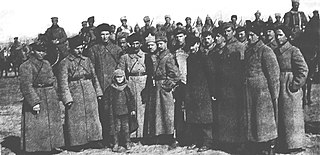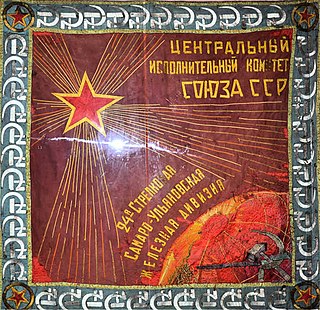
The 1st Cavalry Army was a prominent Red Army military formation. It was also known as "Budyonny's Cavalry Army" or simply as Konarmia.

The 2nd Cavalry Army was a cavalry army of the Red Army during the Russian Civil War.
The cavalry division of the Soviet Union's Red Army was a type of military formation that existed from the early days of the Russian Civil War until the early 1950s when they became obsolete with the rise of mechanized warfare.
The 21st Rifle Division was an infantry division of the Russian Soviet Federative Socialist Republic and then the Soviet Union's Red Army, active between 1918 and 1945.
The 11th Rifle Division was a military formation of the Soviet Union's Red Army. Its personnel were involved in the protection of the demarcation line in Pskov, defensive battles against the Army of the Southern Front in Krasnov Novohopersk - Borisoglebsk, against the army and the forces of Estonia, Bulak Balakhovich in Marienburg in defense of Petrograd and as the offensive against Yudenich's troops in Pskov the Luga-Gdov, Yamburg, Narva, Dvina-Rezhitsk directions, the Polish-Soviet war of 1920, in the suppression of the Kronstadt uprising participated in the Soviet-Finnish War and World War II.
The 24th Cavalry Division was a cavalry division of the Red Army during the interwar period and World War II. It was a prewar division assigned to the Transcaucasus Military District on 22 June 1941. The division was assigned there after participating in the Winter War.

The 51st Rifle Division was an infantry division of the Soviet Army, formed twice. Its first formation was formed during the Russian Civil War and fought in the Perekop-Chongar Offensive in 1920. It also fought in the Soviet invasion of Poland, Winter War and World War II. During World War II, it fought in the Battle of Rostov, Barvinkove-Losowaja Operation and Second Battle of Kharkov before being destroyed at the Battle of Voronezh. Officially disbanded on 28 November 1942, the division was reformed on 15 April 1943 from the 15th Rifle Brigade. The 2nd formation fought in Operation Bagration and the Battle of Königsberg. It was disbanded in an executive order by Premier Joseph Stalin in 1946.
The Orel Military District was a military district of the Russian Soviet Federative Socialist Republic and the Soviet Union. Established in 1918 during the Russian Civil War, the district was disbanded after the end of the war in 1922. It was reestablished during the pre-World War II Soviet buildup in 1938. At the beginning of Operation Typhoon, the German attack on Moscow in October 1941, the district headquarters in the city of Orel was surprised by the German attack and hastily forced to flee the city. After most of the district's territory was occupied, it was disbanded. The district was reformed in 1943 after the area was recaptured and disbanded with the end of World War II in 1945.
The 15th Rifle Corps was a rifle corps of the Red Army, formed five times; each formation was a distinct unit unrelated to the others. It was part of the 5th Army. It took part in the Soviet invasion of Poland in 1939.
The 2nd Cavalry Corps were a corps of the Red Army, formed twice. Originally formed in 1922, the corps served in Ukraine during the Interwar period and fought in the Soviet invasion of Poland.
The 4th Cavalry Corps was a cavalry corps of the Soviet Red Army, formed three times.

The 5th Cavalry Corps was a cavalry corps of the Red Army.

The Kharkov Military District was a military district of the Russian Empire, the Russian Soviet Federative Socialist Republic, and the Soviet Union. Throughout its history, the district headquarters was located in the city of Kharkov in northeastern Ukraine.

The Southern Front was a front of the Red Army during the Russian Civil War, formed twice.

The 14th Army was a field army of the Red Army during the Russian Civil War era.

The 57th Rifle Division was an infantry division of the Red Army during the Russian Civil War.

The 60th Rifle Division was an infantry division of the Red Army during the Russian Civil War.

The 49th Rifle Division was an infantry division of the Red Army during the Russian Civil War, formed twice.

The 68th Mountain Rifle Division was a mountain infantry division of the Red Army before and during World War II.
The 2nd Priamur Rifle Division was an infantry division of the Red Army during the interwar period, originally formed as part of the People's Revolutionary Army (NRA) of the Soviet puppet Far Eastern Republic (FER) during the final stages of the Russian Civil War.






